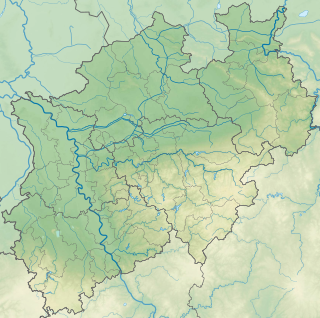Mettmann loess terraces
| Mettmann loess terraces | |||
|---|---|---|---|
| Systematics according to | Handbook of the natural spatial structure of Germany | ||
| Greater region 1st order | Low mountain range threshold | ||
| Greater region 2nd order | Rhenish Slate Mountains | ||
| Main unit group | 33 → Süderbergland |
||
| About main unit | 337 → Bergisch-Sauerland lowlands |
||
| 4th order region (main unit) |
337 1 → Niederbergisch-Märkisches hill country |
||
| 5th order region | 337 1 .0 → Niederbergische Höhenterrassen |
||
| Natural space |
337 1 .00 → Mettmann loess terraces |
||
| Geographical location | |||
| Coordinates | 51 ° 15 ′ 0 ″ N , 6 ° 58 ′ 0 ″ E | ||
|
|||
| local community | Mettmann , Ratingen , Wülfrath , Erkrath , Düsseldorf | ||
| circle | Mettmann district | ||
| state | North Rhine-Westphalia | ||
| Country | Germany | ||
With Mettmanner loess terraces one is natural spatial unit (order number 337 1 .00) of the main unit via Bergisch-Sauerländisches lowlands called (atomic number 337).
They mainly include the urban area of Mettmann in the Niederbergisches Land together with parts of the Düsseldorf , Ratinger and Erkrath East and the Wülfrath West. In the north the natural area borders on the Heiligenhauser Terrassen (337 1 .01) and the Selbecker Terrassenland (337 1 .03), in the south on the Hildener Mittelterrassen (550.12) and in the east on the Düsselhügelland (337 1 .18), the Dornaper Kalkgebiet (337 1 .16), the Haßlinghauser Ridge (337 1 .15), the Wülfrath Kalkgebiet (337 1 .17) and the Vohwinkeler Senke (337 1 .38).
The flat undulating terraced land is largely free of forests and only sparsely divided. In the west, the gravel of the Rhenish main terrace forms the subsoil, in the east the older terrace gravel and, in part, the basement . A mighty loess cover rests on this subsoil , which is only interrupted by loess-free areas at Mettmann. There form gravel knolls such. B. the Sandberg and Wilhelmshöhe the isolated remainder of the older mountain terraces. The annual rainfall of 800 to 950 mm has largely decalcified the loess in the upper class and turned it into loess clay.
The terraced land is structured by terraced ridges running in an east-west direction . The stream valleys between them ( Düssel , Mettmanner Bach , Stinderbach , Hasselbach , Schwarzbach ) gain depth towards the Rhine . In the west they cut into the Upper Oligocene sea sands and in the east into the Devonian basement. The best-known landscape in the natural area is the Neandertal , where the early man named after him was found.

